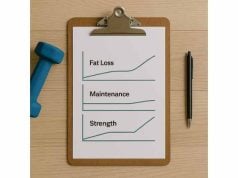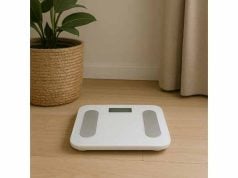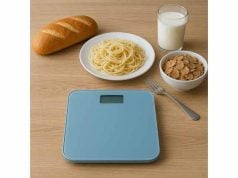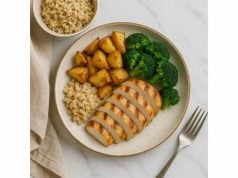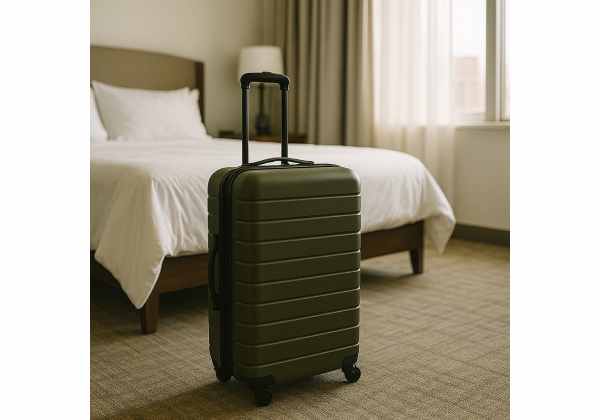
Holidays and trips change your routine, not your goals. You can enjoy special meals, late nights, and time with family while keeping your weight steady—if you install a few sturdy guardrails and let the week average carry the load. This guide gives you simple, repeatable tactics for planes, road trips, hotels, and house stays. You will learn how to set calorie anchors, build high-satiety plates anywhere, manage alcohol and buffets, and decode the scale after flights. If stalls or maintenance puzzles you mid-trip, keep our concise plateau troubleshooting guide nearby.
Table of Contents
- Holiday and travel maintenance
- Plan your calorie anchors
- Build plates and portions
- Alcohol, desserts and sodium
- Move more without workouts
- Weigh-ins, glycogen and bloat
- Simple travel playbooks
- Frequently Asked Questions
Holiday and travel maintenance
Holiday and travel maintenance means holding your weekly average steady while daily choices flex. You are not dieting; you are maintaining, which gives room for celebration meals, later bedtimes, and unfamiliar food. The aim is to return home the same weight within about ±0.5%, with energy and routine intact.
Why “maintenance on purpose” works
- It removes the all-or-nothing trap. A planned indulgence does not become a lost weekend when breakfast and lunch stay predictable.
- It protects strength and mood. Eating enough protein and building high-volume plates tame hunger and keep training or walking enjoyable.
- It travels well. You can build a maintenance-friendly plate at a diner, buffet, or airport with the same template you use at home.
Three decisions to make before you go
- Your weekly calorie band. Choose a realistic maintenance range rather than a single number. For many active adults, that is a ~300–500 calorie swing day to day (e.g., 1,900–2,400) that averages to your norm.
- Your step floor. Pick the number that survives busy days—often 7,000–10,000. Steps are your most flexible lever on the road.
- Your indulgence rule. Decide now: drinks or dessert on any given evening, not both. You can always choose differently tomorrow.
Non-negotiables that stabilize maintenance
- Protein at every meal (25–40 g): eggs and fruit at breakfast, chicken/tofu and salad at lunch, fish or lean meat with vegetables at dinner. Protein first, then sides.
- Volume and water: vegetables, fruit, soups, and potatoes expand the plate without exploding calories. Sip water throughout the day.
- Bedtime boundary: even on holiday, aim for a consistent window. Sleep regulates appetite and impulse control.
What to ignore
- A single high scale reading after the flight or a big meal. Water and glycogen move fast; fat does not.
- The urge to “repair” yesterday with a crash-low breakfast. Eat a normal, protein-forward meal and walk.
If you want a refresher on safe, steady fat-loss fundamentals (useful once you are back home), skim our compact weight loss guide to reconnect your routine.
Key takeaway: Treat maintenance as a plan, not a hope. Decide your calorie band, step floor, and indulgence rule, and let the weekly average do the heavy lifting.
Plan your calorie anchors
Calorie anchors are the two meals and one snack you keep consistent while everything else flexes. On travel days and holidays packed with events, anchors do more to control your weekly average than perfect tracking.
How to choose anchors
- Breakfast anchor (hotel or home):
- 25–40 g protein (eggs, Greek yogurt, skyr, cottage cheese, tofu scramble).
- Produce: fruit or sautéed vegetables.
- Starch: one measured portion (oats, toast, potatoes) if you have an active day.
- Lunch anchor (out or packed):
- Protein entrée: grilled chicken/fish, lean beef, tofu/tempeh.
- Big salad or cooked veg on the side.
- Starch: rice, potatoes, or bread—fist-size portion.
- Snack anchor (afternoon):
- Protein-and-produce (yogurt and berries, jerky and apple, cheese stick and carrots).
- Keeps dinner choices calmer and limits late-night grazing.
Estimated ranges without a scale
- Breakfast: 350–500 calories
- Lunch: 450–650 calories
- Snack: 150–250 calories
That leaves flexibility for a celebratory dinner while keeping the day inside your band.
Tracking made simple
- Use meal shapes instead of exact macros: “protein + produce + measured starch + measured fat.”
- Photograph plates if logging is tedious; estimate later from photos to keep awareness.
- For house rentals, pre-shop: eggs, Greek yogurt, fruit, salad kits, deli meats, microwave rice, olive oil, salt, pepper. A 10-item list solves 80% of meals.
What if you do not know your maintenance?
Set a conservative maintenance estimate from your recent diet or body weight and verify with 7-day averages. If you need a quick method, our practical notes on a solid maintenance estimate will get you close without a calculator.
Two extra levers
- Step swaps: If dinner will be heavier, add an easy 20–30 minutes of walking that day—not as punishment, just as accounting.
- Alcohol cap: Decide the number of drinks before the evening starts. Capping reduces nibbling and empty calories more than you expect.
Key takeaway: Keep two meals and a protein-produce snack consistent. Anchors reduce decision fatigue and protect your weekly average when schedules are chaotic.
Build plates and portions
You can build a satisfying, maintenance-friendly plate almost anywhere if you follow a simple template and watch portion density rather than chasing precision.
The travel plate template
- Half the plate: vegetables or fruit (salads, roasted veg, salsa, fruit cups).
- Quarter of the plate: lean protein (grilled, baked, broiled; sauces on the side).
- Quarter of the plate: starch (potatoes, rice, beans, whole-grain pasta).
- Measured fats: 1–2 tablespoons of oils, dressings, pesto, nut butters, or a small handful of nuts.
High-volume wins in restaurants
- Ask for extra vegetables instead of a second starch.
- Start with a broth-based soup or side salad to reduce entrée intake.
- Choose grilled or baked over fried; request sauces on the side.
- Share dessert or order a mini and savor it.
Buffet blueprint
- First pass: fill half your plate with produce, pick one protein, one starch.
- Second pass: add a small portion of the one dish you really wanted.
- Stop and sit for 10 minutes before deciding on dessert.
Portion calibrators (no scale needed)
- Protein: palm (women) to palm-and-a-half (men).
- Starch: closed fist.
- Fat (oils, dressings): thumb to two thumbs.
- Cheese: two dice.
Breakfast, lunch, dinner examples
- Breakfast: veggie omelet (egg + egg whites), side fruit, one slice toast with a scrape of butter or jam.
- Lunch: salad bowl with grilled chicken, beans, pico, measured vinaigrette; tortilla on the side.
- Dinner: fish with roasted vegetables and potatoes; yogurt-herb sauce instead of cream sauce.
For macro ranges that keep you satisfied between diet phases (and the exact trade-offs between carbs and fats), see our concise guide to macro ranges and tailor the examples to your kitchen or hotel options.
Key takeaway: Use a plate template and measured fats. The plate looks generous, hunger stays low, and calories stay predictable without meticulous tracking.
Alcohol, desserts and sodium
Celebrations are part of travel. You can enjoy them without drift if you make one clear choice per evening and keep sodium steady through the week.
The “two out of four” rule for evenings
Pick two: starter, bread, dessert, drinks. Enjoy them fully; keep the other two minimal. This protects calories and appetite the next morning.
Alcohol guardrails
- Set a weekly cap (e.g., 0–4 drinks total). Decide per event rather than per day.
- Choose lighter options: spirits with zero-calorie mixers, dry wine, light beer.
- Alternate each drink with water; finish with a protein-forward snack if dinner was light.
- Avoid late-night grazing by eating a real dinner first.
Dessert strategy
- Share or order the smallest portion; savor slowly.
- If dessert is the star, skip bread and starter, and keep the entrée protein-centric.
Sodium consistency
- Restaurant meals swing sodium wildly; your body holds more water, the scale jumps, and you feel puffy.
- Cook or assemble low-sodium breakfasts and lunches (eggs, fruit, yogurt, salads). Let dinner be salty without turning the whole day into a salt bomb.
Morning after a big night
- Hydrate, walk 20–30 minutes, and eat your normal breakfast anchor.
- Do not “punish” with a near-zero breakfast; it backfires by lunchtime.
If alcohol tends to stall your progress or trigger overeating, read the practical strategies in our focused alcohol playbook and pick one or two tactics to use this trip.
Key takeaway: Enjoy the event by choosing two of four (starter, bread, dessert, drinks), keeping sodium steady, and returning to anchors the next morning.
Move more without workouts
You might not train on schedule during holidays or work travel. That is fine. Your most reliable calorie lever is NEAT—non-exercise activity like walking, stairs, and standing.
Step floor, not step PR
- Choose a daily floor you can hit on your busiest day (often 7,000–10,000). Floors keep you consistent; PRs create guilt and drop-offs.
Movement you can sneak in anywhere
- Walk 10–20 minutes after larger meals; invite family or a colleague.
- Use stairs for any climb under five floors.
- Turn calls into walk-and-talks.
- Park once and loop the area; airports are built for steps.
Hotel and house micro-workouts (15–20 minutes)
- 5 rounds: bodyweight squats, incline push-ups, split squat holds, plank.
- 10 minute EMOM: alternating swings (dumbbell/backpack) and mountain climbers.
- Stretch hips and upper back at night to improve sleep.
Why this matters
- NEAT swings explain why the same food can maintain you at home but add weight on the road. Keeping steps steady preserves your maintenance band.
- Easy walking also improves digestion, reduces “puffy” feelings after salty meals, and steadies appetite.
For a deeper plan to prevent your daily movement from collapsing during a diet (or after it), skim our notes on how to keep daily movement up and adapt one or two ideas to this trip.
Key takeaway: Protect a step floor and add short walks after meals. Small, repeatable movement beats missed gym sessions for maintenance.
Weigh-ins, glycogen and bloat
Travel changes water, glycogen, and gut content more than fat. Expect noise. Read your numbers with weekly averages and context.
What makes the scale jump on trips
- Flights: long sitting and cabin pressure shift fluids to the extremities; dehydration plus salty snacks adds water retention.
- Higher carbs: more glycogen stores and the water that travels with them mean a temporary rise—useful for energy.
- Restaurant sodium: two salty dinners in a row can mask a stable calorie week.
- Food volume: bigger meals and slower transit temporarily add scale weight.
How to weigh (or not) during travel
- Optional: weigh day of departure and 2–3 days after returning. Skip daily weigh-ins if they spike anxiety.
- If you do weigh: use the same morning routine and compare 7-day averages at home, not isolated travel days.
When to act vs. wait
- If weight is up but waist and rings feel the same, wait 3–5 days and normalize sodium, sleep, and steps.
- If weight and waist climb for two weeks, trim 100–150 calories/day or add 1,500–2,000 steps/day.
For a simple, repeatable method you can use year-round, follow our daily weigh-in protocol so single mornings never drive decisions.
Key takeaway: Travel-related jumps are water and glycogen, not fat. Judge by 7-day averages, waist, and how your clothes fit once you are home and sleeping normally.
Simple travel playbooks
Turn ideas into ready-to-run micro-plans you can reuse every trip.
Long flight day
- Breakfast anchor at home (protein + produce).
- At the airport: water, black coffee or tea, fruit cup, yogurt, or a protein box; skip pretzels and oversized muffins.
- Onboard: protein snack you packed; say yes to water every round.
- Land and walk 10–20 minutes before dinner; keep dinner protein-forward.
Road-trip day
- Cooler with Greek yogurt, precut fruit, baby carrots, jerky or deli turkey, microwave rice cups.
- Gas station: water, fruit, string cheese, lightly salted popcorn.
- Lunch: burrito bowl or sandwich shop—double vegetables, skip extra sauces.
- Hotel: short bodyweight circuit; early lights-out.
Hotel week (work travel)
- Breakfast buffet: eggs or omelet, fruit, small potatoes or toast; skip pastries most days.
- Lunch: salad or grain bowl with a lean protein; vinaigrette measured.
- Dinner: “two out of four” rule; walk after.
- Step floor: schedule walk-and-talk calls.
Family holiday at home
- Keep breakfast and lunch high-volume and predictable.
- Choose your celebration meal once per day; enjoy it without rules.
- After meals, take a group walk or organize yard games.
- Keep alcohol or dessert, not both, on more than one night.
Airbnb or house rental
- First grocery run: eggs, yogurt, fruit, salad kits, pre-washed greens, microwavable rice, frozen vegetables, chicken or tofu, olive oil, salt, pepper.
- Default dinner: sheet-pan protein and vegetables; fruit for dessert.
- Plan one restaurant dinner every other night; enjoy it, then return to the default.
Reset the week you return
- Resume anchors day one.
- Normalize sodium and bedtime.
- Weigh any day you like, but compare weekly averages to pre-trip, not yesterday.
Key takeaway: Pre-decide a default day for each travel type. The default carries you from one indulgent meal to the next without drift.
Frequently Asked Questions
How many calories should I target on holiday?
Use a maintenance band, not one number—usually your home maintenance with a ±150–250 swing. Keep two meals and a protein-produce snack consistent, then let dinner flex. Judge success by 7-day averages and waist fit once you are home and sleeping normally.
Do I need to track every bite while traveling?
No. Track shapes, not grams: protein + produce + measured starch + measured fat. Photograph plates to estimate later if you like. Anchors at breakfast, lunch, and one snack keep the day predictable even when dinner is social or unplanned.
How do I handle buffets without overeating?
First pass: half plate produce, one protein, one starch. Sit and eat, then wait 10 minutes. Second pass: add a small portion of the dish you most wanted. Use water between plates, and decide dessert or drinks, not both, for the evening.
What if the scale jumps after a flight?
Flights change water distribution and sodium balance; higher carbs add glycogen and its water. This raises the scale without adding fat. Hydrate, walk 20–30 minutes, return to anchors, and reassess after 3–5 days of normal sleep and sodium.
Can I drink alcohol and still maintain?
Yes—with guardrails. Cap total weekly drinks, alternate with water, and keep dinners protein-centric. Use the “two out of four” rule at restaurants (starter, bread, dessert, drinks). Alcohol drives extra snacking, so eat a full meal before drinking.
Should I work out or just walk?
Walk first. A step floor of 7–10k is more reliable than sporadic hotel workouts. Add short bodyweight circuits if you enjoy them. The goal is consistency, not PRs; movement supports appetite control and steadies your weekly average.
References
- Advances in Understanding the Interplay between Dietary Practices, Body Composition, and Sports Performance in Athletes 2024 (Review)
- The acute effects of breaking up prolonged sitting on postprandial glycemia, insulinemia, and triglyceridemia: A systematic review and meta-analysis 2022 (Systematic Review & Meta-analysis)
- Non-Exercise Activity Thermogenesis in Human Energy Homeostasis 2022 (Review)
- Daily steps and all-cause mortality: a meta-analysis of 15 international cohorts 2022 (Meta-analysis)
- Muscle Glycogen Assessment and Relationship with Body Hydration Status: A Narrative Review 2022 (Narrative Review)
Disclaimer
This article provides general education about nutrition, activity, and weight maintenance. It does not replace personalized advice from a qualified healthcare professional. If you have medical conditions, take prescription medications, are pregnant or breastfeeding, or have a history of disordered eating, seek individual guidance before changing diet or activity.
Share and follow
If this guide helped you enjoy travel without losing momentum, consider sharing it with a friend planning a trip. For practical updates and new articles, you are welcome to follow us on the platforms you prefer—Facebook, X, Instagram, or LinkedIn.


